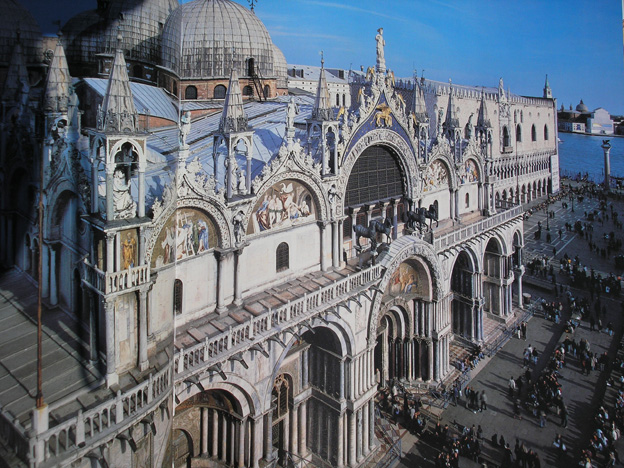



Venice:






Associazione Guide Turistiche Venezia
|
|


 
Guided
tour of S. Mark's area - 2 hours
The
Piazza San Marco, the Basilica,
the Palazzo Ducale
and the
Marciana Library
without a doubt represent the essential attractions of the city.
For any visitor to Venice, and certainly one visiting for the first
time, they are an absolute must. With this guided tour of two hours
(recommended three hours for an exhaustive visit to the Basilica's
Loggia and State Prisons) you will ease into Venice's history through
its highlights.
The
buildings facing Saint Mark Square
and the nearby Piazzetta represent
the seat of the power of La Serenissima from its foundation in the
9th century, through the age when it grew to dominate the Eastern
Mediterranean and stretched its influence far beyond. Its present
form is substantially that of the 16th century Doge Andrea Gritti,
whose far-sighted ideas moved the existing stalls, shops and markets
to the Rialto and established in their place the Marciana
Library, a masterpiece of stately design by Jacopo Sansovino.
His work was, in turn, the inspiration for the civil-service offices
that look down on the Piazza San Marco (the Procuratie)
now occupied largely by the Museo Correr.
However,
the supremely dominant attraction of the Piazza is the Basilica
of St. Mark itself, the most significant example of Byzantine
architecture in Western Europe. It was begun in 832 AD as the private
chapel of the Doge, incorporated into the Ducal Palace itself. Here
the remains of St. Mark himself, 'rescued' from Alexandria in Egypt
a few years previously, were laid. A witness to the power and wealth
of the city, here the great ceremonies of state were celebrated,
as many paintings testify. Now it is the seat of the Patriarch of
Venice, while its vastness, the four thousand
square metres of mosaic and the deep gold of the walls and
domes astonish and humble the visitor. The mosaics
represent 'the Bible of the poor', to be both an embellishment
of the basilica and lessons in the faith of the Old and New Testaments.
There is material for hours of study, but recommended above all,
after the basilica itself, is the Pala d'Oro,
the Museo della Basilica and
the Loggia, from which you can share the view of the four
famous horses, the Quadriga, as they
look down over the Piazza. From the Loggia you can also enjoy a
fine view of one face of the Ducal Palace and the basin beyond.
The horses on the Loggia are not the originals. You can see these
in the museum, fine examples of ancient Greek gilded bronze. They
are difficult to date, perhaps second or third century BC, and may
have been part of an even greater work, one of Apollo driving his
chariot across the heavens. The museum also displays a collection
of tapestries and examples of original mosaics removed during restoration
in the 19th century.
Our
final obligation is the visit to the Ducal
Palace. First built in the 9th century as a moated fortress,
what we see today is the result of a complete rebuilding in the
1340s in an elaborate gothic style. The long monumental facades,
facing the Library and the basin, constitute a formidable example
of elegance and functionality. Their originality is the reversal
of the more usual architecture which sets lighter elements above
the heavy: here an elegant colonnade is topped by the massive masonry
of the upper floors. The functionality is in the avoidance of the
chill from the water invading the great chambers where various councils
sat, including that of the Chamber of the
Maggior Consiglio, which counted almost 2500 members, a space
that occupies on its own a large proportion of the Palace. With
no columns to support the ceiling, it is still one of the largest
single-span spaces in Europe. While the exterior of the Palace is
late mediaeval, the interior is essentially late renaissance; frequent
fires have destroyed large parts of the original. The last major
fire in 1574, however, had a 'fortunate' effect because Paolo
Veronese and Jacopo Tintoretto,
and later their sons, were commissioned to paint new canvasses for
the great chambers (Chamber of Pien Collegio).
Equally significant restoration was carried out by Andrea
Palladio (the Room of the Four Doors).
Here also there is a portrait by Titian
of the Doge Antonio Grimani, which also survived the fire since
it was still in the artist's studio at the time. You will also be
able to see, in the hall of the Magistrati alle Leggi, several paintings
by Hieronymus Bosch, the only ones
in Italy. Touring the Palace, it is well to reflect that of all
Venice, the Ducal Palace suffered most from the depredations of
Napoleon during the nine years of his reign in Italy. Your tour
of the palace will conclude in following the footsteps of prisoners
of the state across the Bridge of Sighs
to the 'New Prison'.
In
perhaps two hours you will have been led through a millennium of
the history of Venice. But history continues, and as we step out
of the Pallazo Ducale onto the waterfront, it will be appropriate
to discuss some of the problems of Venice today, especially if you
have encountered one of the not infrequent incursions of the lagoon
into Piazza San Marco.

 

|
GUIDETOVENICE
MARTINO RIZZI
Cell. +39 3289485671
e-mail
|
|
|
|















